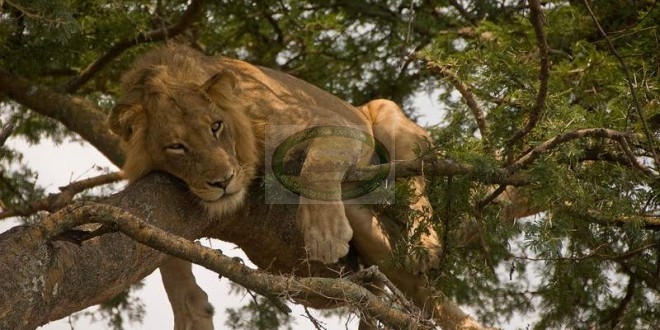Queen Elizabeth National Park is Uganda’s most popular National Park located Southwest, near Kasese with 1,978 sq km. Is certainly one of its most scenic? It stretches from the crater-dotted foothills of the Rwenzori ranges in the north, along the shores of Lake Edward to the remote Ishasha River in the South, incorporating a wide variety of habitats that range from wetlands to savannah to lowland forest.
The lush savannah of Queen Elizabeth National Park offers prime grazing to buffaloes, elephants, various antelopes and a variety of over 600 bird species.
The rolling grasslands are set against the backdrop of the jagged, snow-capped Rwenzori Mountains making the breathtaking landscapes a photographer’s dream. Lake Edward and the much shallower Lake George are often visited by local fishermen, and small crater lakes are home to many buffalo and flocks of pink flamingo.
Queen Elizabeth spans the equator line; monuments on either side of the road mark the exact spot where it crosses latitude 00.
The park was founded in 1952 as Kazinga National Park, and renamed two years later to commemorate a visit by Queen Elizabeth II.
The Katwe explosion craters mark the park’s highest point at 1,350m above sea level, while the lowest point is at 910m, at Lake Edward.
Tourism Activities in Queen Elizabeth National Park:
- Boat cruises on the Kazinga Channel offer incredible views of birds and wildlife
- Game viewing, particularly in the Mweya Peninsula and Kasenyi, as well as the Ishasha Plains – home to the tree-climbing lions
- Bird watching – the Park is home to over 600 species of birds
- Chimp tracking in Kyambura Gorge
- Maragambo Forest walks – great for bird watching and monkey spotting
- Crater Lakes – the almost perfectly circular lakes on these extinct volcanoes form an incredible landscape
Wildlife
Queen Elizabeth National Park has an incredible variety of primates – from habituated chimps and playful baboons to vervet, colobus and red-tailed monkeys. Visitors will also enjoy a classic safari with buffalo, lions, bushbucks, waterbucks, elephants, hippos and the occasional leopard, while smaller creatures such as warthogs and banded mongooses are as abundant. While visitors should never approach the wildlife, animals will often stray into the roads and even the lodge grounds – an incredible experience! Night forest walks provide the opportunity to spot nocturnal mammals such as the wide-eyed galagos (bushbabies) and pottos – and hear the eerie shrieks of tree hyraxes.
Birding
Queen Elizabeth National Park’s impressive array of habitats means that over 600 species of birds have been identified here. Many water-associated birds live along the Kazinga channel, on the swampy shores of Lake Edward and in the Kyambura wetlands, including various herons, storks, plovers, jacanas, crakes, flamingoes and even shoebills. Bright yellow weaver birds and their impressive nests are everywhere. Beautiful, tiny sunbirds are also common, as are the immense, scavenging marabou storks.
As well as its outstanding wildlife attractions, Queen Elizabeth National Park has a fascinating cultural history. There are many opportunities for visitors to meet the local communities and enjoy storytelling, dance, music and more. The gazetting of the park has ensured the conservation of its ecosystems, which in turn benefits the surrounding communities.Uganda’s Queen Elizabeth National Park is truly a Medley of Wonders!
Experience Uganda with Green Hills Ecotours local guides will give you the great opportunity to explore the scenic beauty, history, diverse culture and enjoy the local food while interacting with local people. Come experience the adventure of a lifetime; A destination to quiet your mind and regenerate your spirit. Book your eco-friendly holiday tour at: ecotours@gmx.com
 Green Hills Ecotours For all kinds of tours in Central Africa
Green Hills Ecotours For all kinds of tours in Central Africa
